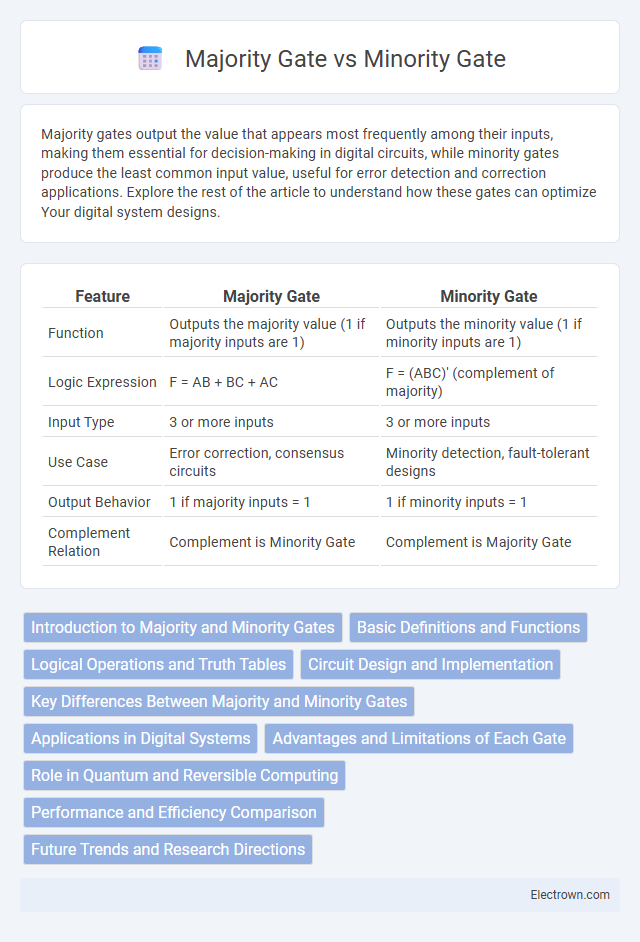Majority gates output the value that appears most frequently among their inputs, making them essential for decision-making in digital circuits, while minority gates produce the least common input value, useful for error detection and correction applications. Explore the rest of the article to understand how these gates can optimize Your digital system designs.
Table of Comparison
| Feature | Majority Gate | Minority Gate |
|---|---|---|
| Function | Outputs the majority value (1 if majority inputs are 1) | Outputs the minority value (1 if minority inputs are 1) |
| Logic Expression | F = AB + BC + AC | F = (ABC)' (complement of majority) |
| Input Type | 3 or more inputs | 3 or more inputs |
| Use Case | Error correction, consensus circuits | Minority detection, fault-tolerant designs |
| Output Behavior | 1 if majority inputs = 1 | 1 if minority inputs = 1 |
| Complement Relation | Complement is Minority Gate | Complement is Majority Gate |
Introduction to Majority and Minority Gates
Majority gates output a logic high when the majority of their inputs are high, making them crucial in fault-tolerant and decision-making circuits. Minority gates perform the inverse operation, outputting a logic high only when the minority of inputs are high, often utilized in error detection and correction systems. Both gates play vital roles in digital logic design, offering alternative methods for implementing complex Boolean functions with efficiency and reliability.
Basic Definitions and Functions
A Majority Gate outputs a logic high value when the majority of its inputs are high, performing a voting function essential in fault-tolerant circuits. Conversely, a Minority Gate produces a logic high output only when fewer than half of its inputs are high, acting as the inverse of the Majority Gate. Understanding these fundamental functions helps you design robust digital systems with optimized decision-making capabilities at the gate level.
Logical Operations and Truth Tables
Majority gates output a logic high (1) when the majority of their inputs are high, whereas minority gates output a logic high only when the minority of their inputs are high. The truth table of a majority gate with three inputs shows output 1 for input combinations with two or more ones, while the minority gate truth table produces output 1 for input combinations with zero or one ones. Both gates are fundamental in fault-tolerant computing and digital circuit design due to their unique logical operations.
Circuit Design and Implementation
Majority gates output the value held by the majority of their inputs, making them essential in fault-tolerant circuit design and error correction implementation. Minority gates, conversely, output the logical complement when most inputs are high, useful in applications requiring inverted majority decisions or specialized logic synthesis. Understanding the unique switching characteristics and input configurations of these gates allows you to optimize circuit complexity and power efficiency in hardware implementations.
Key Differences Between Majority and Minority Gates
Majority gates output a logic high signal when the majority of their inputs are high, while minority gates produce a logic high output only when the minority of their inputs are high. Majority gates are often used in fault-tolerant systems and voting circuits due to their ability to determine the prevalent input condition. Minority gates, conversely, serve in specialized decision-making circuits where detection of minority input states is critical for specific logic operations.
Applications in Digital Systems
Majority gates play a crucial role in fault-tolerant digital systems by enabling error correction through redundancy, making them essential in applications such as voting systems and reliable arithmetic circuits. Minority gates, while less common, are used in specific logic functions where detecting minority conditions is vital, including some security and control circuits. Your digital design can benefit from incorporating majority gates for enhanced reliability and minority gates for specialized decision-making tasks.
Advantages and Limitations of Each Gate
Majority gates excel in digital circuits by providing robust decision-making based on multiple inputs, enhancing fault tolerance and reducing noise susceptibility, but their complexity increases with the number of inputs, impacting speed and power efficiency. Minority gates offer simplicity in implementation and effective minority value detection, which benefits error correction and voting mechanisms, yet they face limitations in scalability and may suffer from reduced circuit reliability in complex systems. Both gates have unique applications where their operational advantages outweigh their inherent constraints, guiding optimal usage in logic design and nanotechnology.
Role in Quantum and Reversible Computing
Majority gates play a crucial role in quantum and reversible computing by enabling efficient logic synthesis and error correction through their ability to output the most common input value, thus facilitating fault-tolerant design. Minority gates, which output the least common input value, complement majority gates by providing alternative logic functions essential for reversible circuit design, a key aspect of minimizing heat dissipation in quantum systems. Your implementation of quantum algorithms benefits from leveraging these gates to optimize circuit complexity and enhance computational coherence.
Performance and Efficiency Comparison
Majority gates offer superior performance in fault-tolerant computing due to their ability to output the most common input value, reducing error rates in noisy environments. Minority gates, while less common, can provide efficient logic simplification in specific complementary circuit designs, minimizing gate count and power consumption. Performance metrics reveal majority gates excel in speed and reliability, whereas minority gates optimize efficiency in specialized low-power applications.
Future Trends and Research Directions
Emerging research in logic design emphasizes advancing Majority Gate technology due to its potential for reducing circuit complexity and power consumption in nanoscale computing. Future trends explore hybrid architectures integrating Majority and Minority Gates to enhance fault tolerance and computational efficiency in quantum and neuromorphic systems. Your innovation strategies could benefit from leveraging these developments to optimize performance in next-generation digital circuits.
Majority Gate vs Minority Gate Infographic

 electrown.com
electrown.com